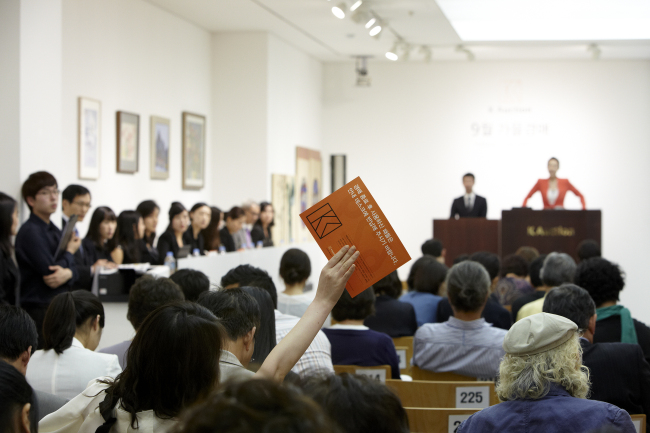Corporate buying needed to boost art market in Korea
Auction of large-scale works, government policies could encourage businesses to start art collections
By Lee Woo-youngPublished : April 17, 2013 - 20:23
K-Auction, one of the top auction houses in Korea, decided to hold a sale devoted to large-scale paintings on April 24 in anticipation of corporate buyers’ desire to acquire artworks when prices appear to have hit rock bottom.
Corporate buyers make up a very small portion of art collectors in Korea and most of them are hesitant to start collections or expand their existing ones because in Korea, art collections are largely perceived as speculative investments by the wealthy.
“It’s very rare for a Korean company to buy artworks. Almost 80 percent of art buyers in Korea are individual buyers. If we have more corporate buyers, they will help the art market recover faster,” said Lee Hwa-ik, owner of the eponymous gallery in Seoul.
Corporate buyers make up a very small portion of art collectors in Korea and most of them are hesitant to start collections or expand their existing ones because in Korea, art collections are largely perceived as speculative investments by the wealthy.
“It’s very rare for a Korean company to buy artworks. Almost 80 percent of art buyers in Korea are individual buyers. If we have more corporate buyers, they will help the art market recover faster,” said Lee Hwa-ik, owner of the eponymous gallery in Seoul.

Art collecting by CEOs also remains secretive in Korea and their donations to museums are rare, unlike in other nations such as the U.S. and emerging countries in the Middle East like Qatar and the United Arab Emirates.
“Recently, the heir of the Estee Lauder fortune donated Cubist artwork to the Metropolitan Museum of Art in New York. It shows how a collector’s donation can make a huge contribution to enhancing the cultural level of a society,” said Son Yee-chun, public relations department manager of K-Auction.
The April 24 auction targets corporate buyers with artworks that are larger than 130 centimeters in width and 160 centimeters in height ― the large sizes are more suitable for decorating corporate buildings rather than private homes.
“Popular artworks that sell well in the Korean art market are small works that fit well in someone’s home as a dcor item,” said Son. “The Korean art market which depends on small paintings favored by individual collectors has reached a limit in growth, which in turn puts a psychological burden on young artists who want to get creative regardless of the size of their artworks,” she explained.
Son said the auction may be a good opportunity for companies considering to create a collection as part of their corporate social responsibility effort, or to enhance their images.
“Now we see some corporate buildings with artworks in their lobby. But it’s not the usual case. Most businesses don’t know how to start art collections,” she said.
Son said the auction offers a good chance for novice corporate buyers to purchase artworks and start collections because the starting prices are set 60-70 percent lower than the estimates.
The starting price of the abstract painting “Untitled 07-2-13” by established artist Jung Sang-hwa is 40 million won ($36,000), significantly lower than its estimate of 60 million to 70 million won.
But corporate buyers have very few incentives to collect art, especially when conglomerates are suspected of creating slush funds with artworks, with the recent investigation into Seomi Gallery’s tax evasion and its alleged links with conglomerates being a glaring example.
Opera Gallery Seoul started a loan service for corporations and public institutions who feel it as a burden to purchase artworks.
“We don’t even receive requests for loans. We were wondering why they don’t even come for loans,” said Yoon Jeong-ah, director of Opera Gallery Seoul.
“We were planning to launch business-to-business art marketing last year, but since the probe into Seomi Gallery, we have become hesitant to start it up,” said Yoon.
The Korean art market is hoping for a rebound with a new Culture Ministry initiative. The ministry, during a briefing to President Park Geun-hye on March 28, said it would increase the amount allowed for a corporation to purchase artwork within corporate expenses from 3 million won to 30 million won.
Some experts note that it will encourage small and medium-sized companies to purchase artworks. But some say it is still not enough to boost corporate art spending.
“Some expect it will encourage companies to buy artworks, but 30 million won is not enough as most of the large works cost more than that,” said Yoon.
By Lee Woo-young (wylee@heraldcorp.com)







![[KH Explains] How should Korea adjust its trade defenses against Chinese EVs?](http://res.heraldm.com/phpwas/restmb_idxmake.php?idx=644&simg=/content/image/2024/04/15/20240415050562_0.jpg&u=20240415144419)











![[Today’s K-pop] Stray Kids to return soon: report](http://res.heraldm.com/phpwas/restmb_idxmake.php?idx=642&simg=/content/image/2024/04/16/20240416050713_0.jpg&u=)